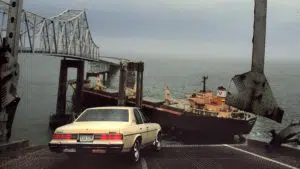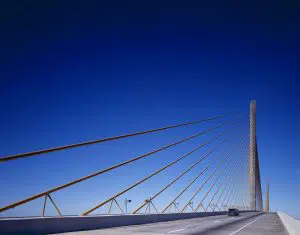One of my favorite things about the Tampa Bay Area (besides the natural beauty, of course…) is discovering the its unique history. That’s what a writer loves to do — we soak up everything. And in the process, we’re able to see how the big picture developed and show it to you through our stories.
Very often, the things I learn about Tampa inform the fiction in my books.
Such as the island where Judge Willa Carson lives my fantasy life, Plant Key, and her home, George’s Place. You can read about it here.
The Sunshine Skyway bridge is one of Tampa’s best highlights.
The bridge is the longest cable-stayed concrete bridge in the world, spanning 6.7km from St. Petersburg to Bradenton, Florida. More than 50 thousand vehicles cross the bridge each day. The bridge’s popularity comes not only from its bright taxicab yellow cables but also from its tragic history.
On the morning of May 9th, 1980, a violent thunderstorm pushed the freighter Summit Venture off of its course, causing it to crash into the original Skyway bridge.
The freighter was riding higher in the water because it was empty, making it more difficult to control in the strong winds.
The crash caused over 1000 feet of the bridge to collapse into the bay. A Greyhound bus and seven vehicles went over the edge, resulting in 35 deaths.
Wesley MacIntire’s Car – Image courtesy of TampaBay.com
Wesley MacIntire was the only victim to survive the fall. His pickup truck fell onto the ship below, allowing him to escape his vehicle just before it entered the water.
Dick Hornbuckle and his three passengers witnessed the Greyhound bus fall over the edge, barely stopping in time themselves. The bus had passed Hornbuckle’s car moments earlier as they approached the hump of the bridge. His quick thinking spared not only his and his passenger’s lives but also those of oncoming traffic, whom he warned immediately.
The original Sunshine Bridge had been in place for nearly 30 years before the tragic accident. The bridge was deemed unfixable and was demolished in 1993.
The remaining supports were eventually turned into fishing piers.
While the demolition took place in a matter of minutes, rebuilding the bridge was a much more complex and expensive process.
The undamaged side of the bridge continued to be used while the new bridge was under construction.
A new bridge design was created by Figg and Muller Engineers, and construction began in 1982. The new design featured the iconic twin golden spires that meet at the entrance of Tampa Bay.
It took seven years to build the new bridge at a cost of $240 million. The greatest challenge of the project occurred on July 30, 1984, when a crane collapsed while attempting to lift the first concrete segment. In all, over 500 people worked on the bridge.







Comments are closed.